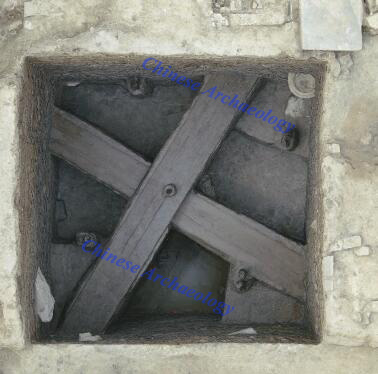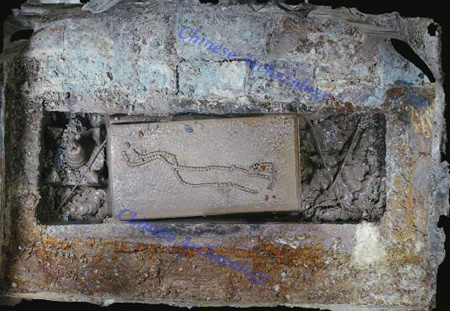The excavation of Qinglong town site in Shanghai has significant discoveries
From:Chinese Archaeology NetWriter:Date:2017-04-13
From 2010 to 2016, Archaeological Research Department of Shanghai Museum has carried out a long-term exploration and excavation at Qinglong town site in Baihe town, Qingpu district, Shanghai. They found many new discoveries and achieved important archaeological results. The total excavation area is 5,000 square meters. According to the exploration results, the core area of the town is about 6 square km, with complete street layout. It was a very large town at that time. Qinglong town was built in the 5th year of Tianbao reign during Tang dynasty and was still in use till Ming dynasty.
The aerial photo of the foundation of the Longping Temple
Archaeological Discoveries
The Qinglong town site is mainly distributed along both sides of the river, reflects the characteristics of Canal Towns in Southern China. Remains such as house foundation, well, hearth, and workshop of Tang and Song dynasties have been found. The porcelains excavated from the site were mainly made from the southern kilns, such as the Yue kiln, Deqing Kiln, Changsha Kiln of Tang dynasty, and the Fujian MinqingYi Kiln, Longquan Kiln, and Jingdezhen Kiln of Song dynasty. Among them, many porcelains made from Fujian kilns are similar to the porcelains discovered in korean peninsula and Japan, which indicates the porcelain was transported to Qinglong town from Fujian and Jiangxi, and then exported to Korea and Japan by sea.
The key landmark in the literature records - the foundation of the tower of Northern Temple (known as Longping Temple) was discovered. The tower foundation is standing in the northern part of the ancient Qinglong town, near the Wusong River today. Because of the important location, it is suggested that the tower was used as a lighthouse, which was given two functions, one was to spread Buddhism, and another one was to use as a navigation mark, guiding busy commerce ships into the Wusong River harbor.
The tower footing of Longping temple is relatively complete. The masonry is octagonal. There are side steps in the two cloisters outside the body of the tower. The tower footing was built by the rammed earth. The crypt is the center of the tower footing. Two cross-intersected wood planks were used to seal and protect the upper part of the crypt. The structure is very special and different to other tower footings ever excavated in China. This provides important information on the research of the building technology used to build the tower foundation under the soft soils and the burial system of Buddhist relics in the southern part of China during Northern Song dynasty. It is very important to the study of ancient Chinese architectural history.

The underground palace and the Wooden beam structure in the foundation of the Longping Temple
The crypt found inside the tower footing is completely preserved. It has a similar structure to the tower. The shape of the underground palace is rectangular, with a length of 1.48 m from east to the west, a width of 1.2 m, and a height of 1.42 m. The lower part of the crypt has a Sumeru throne built by three-story piled bricks; the middle part is girdled; the body of the palace is a straight wall; and a trapezoid stone is used to cover the brick seal at the top part. The inside wall of the palace room was built by flagstones. Numerous ancient coins of different period were also found on the floor. The earliest coins found are the Wuzhu coins of Han dynasty and the latest coins found are the Tianxi Tongbao coins of Northern Song dynasty. A mysterious case containing a statue of Sakyamuni was found. Two gilded-pagodas were placed to guard the container, one at the left side and the other one at the right side. The container has four layers – wood, iron, gold, and silver. A statue of Sakyamuni, the founder of Buddhism, was found at the bottom of the silver layer. On the other hand, four round beads were found in the copper bottle within the container, which are the Buddhist relics. These archaeological discoveries suggest that Buddhism was already prosperous in that area during Tang and Song dynasties. Therefore, the discovery of the underground palace of Longping Temple and the Buddhist cultural relics is also very important to the research on the spread of Buddhism in China.

The underground palace
An ancient well of Song dynasty was found in the west part of southwest of the Longping Temple tower footing. The depth of the well is about 4.5 m. Inscriptions about how people donated bricks to build the well are found on the bricks of the well. The mouth of the well was built at similar time as the tower foundation, and it was also built by the donated bricks.
Academic Significance
After many years of archaeological excavation and exploration, the range of Qinglong town site has been basically found. The archaeological excavation of Qinglong town site has not only filled the gap in our understanding of the urban cultural development in Shanghai area during Tang, Song, and Yuan dynasties; but also pushed the history of Shanghai as important foreign trade center a big step forward. The unearthed porcelains also verifies historical documentary records, showing Qinglong town was an important port on the Maritime Silk Road. The tower footing of Longping Temple is the first archaeologically confirmed ancient tower remains found in Shanghai, which has great value to the study of the layout of Qinglong town and the secularization of Buddhism in the Tang and Song dynasties. (Translator: Li Xuelei)

